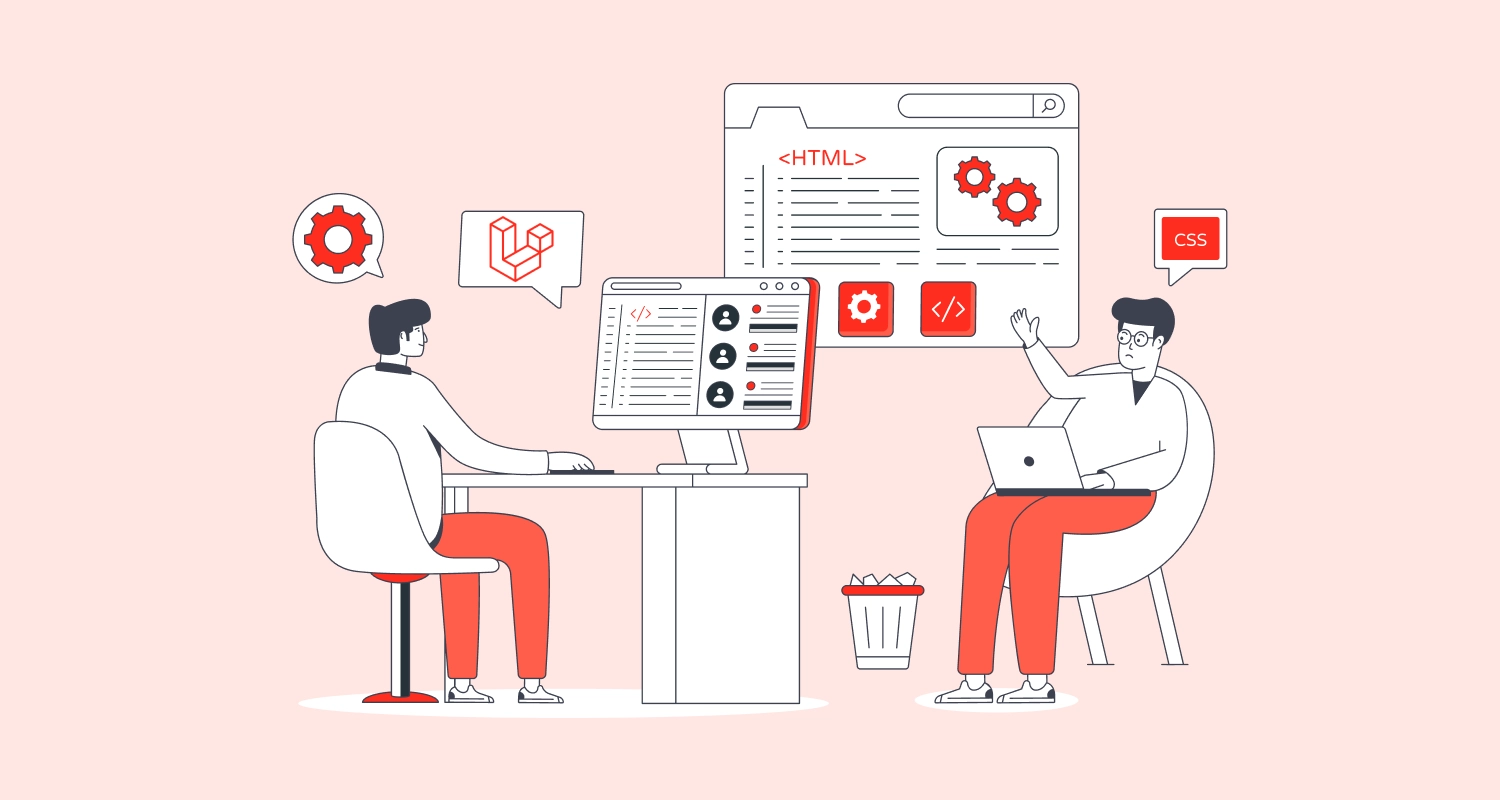Before jumping onto what’s new with Laravel Cloud in 2025, let’s quickly recap Laravel’s journey of providing constant innovations and solutions. Ever since its inception in 2011, Laravel has been on the forefront of providing secure, scalable and rapid web application and API development services. One of the biggest USP (unique selling points) of Laravel is how it provides its personal ‘Laravel Ecosystem’.
Laravel provides a collection of first-party packages that provide pre-defined solutions for common challenges, so the developers don’t need to reinvent the wheel and waste time solving those challenges. This is the level of thought with which Laravel has built its entire ecosystem.
Building on the same principle, Laravel has now tapped into the most anticipated market in 2025 – the cloud market.
Now,you may have questions like –
- What is Laravel Cloud?
- Is there a need to shift to Laravel Cloud?
- How can you migrate your existing project to Laravel Cloud?
- Will Laravel Cloud be free?
- How does the Laravel Cloud API help with automation and integration?
Today, in this blog we plan to uncover what Laravel Cloud is, its key features and applications and how it can benefit your projects in 2025.
What is Laravel Cloud? How does it stand out?
Laravel Cloud offers more than hosting options, it’s also a strategic extension of the Laravel ecosystem into deployment, scalability, and DevOps. In 2025, Laravel Cloud is redefining how developers deploy, scale, and manage applications in production, making end-to-end development truly seamless from code to cloud.
Laravel Cloud vs Forge and Vapor
Laravel used to rely on tools like Vapor for handling serverless deployment and Forge for provisioning. While powerful in their own right, they often required developers to juggle different workflows, especially when teams needed to support hybrid infrastructure. Laravel Cloud brings a unified environment that merges provisioning, deployment, and scaling into one seamless experience, cutting down the cognitive load and ops complexity.
How Laravel Cloud Simplifies Developer Workflows
Laravel Cloud eliminates the need for manually setting up deployment pipelines or worrying about SSH configurations. Developers can deploy directly from GitHub with environment variables automatically handled. With built-in rollbacks and caching layers, even hotfixes and patches are deployed in seconds. The simplicity doesn’t compromise control—in fact, it reinforces Laravel Cloud best practices by improving observability, automation, and deployment reliability.
New Technical Features Driving Laravel Cloud in 2025

Here are the key features of Laravel Cloud that will redefine cloud computing for PHP-based applications:
Edge Computing and Region-Aware Deployments
Laravel Cloud now supports edge computing, allowing applications to run closer to the end user. This results in faster load time, reduced latency and more responsive experience. Developers can choose specific regions during Laravel deployment and Laravel Cloud handles the intelligent routing of requests. You can develop SaaS Applications Using Laravel with compliance needs.
Predictive Auto-Scaling with AI Integration
One standout feature in 2025 is predictive auto-scaling. Laravel Cloud uses AI models to monitor historical request data and traffic trends, adjusting server capacity before load spikes occur. This preemptive scaling ensures optimal performance under high traffic without overspending on idle resources. It also integrates seamlessly with Laravel Octane for performance gains.
Built-in Monitoring and Debugging Tools
Laravel Cloud includes an observability suite out of the box. Developers get access to real-time logs, performance charts, and error reports via an intuitive dashboard. Laravel Telescope is tightly integrated for debugging, while custom log streamers make it easy to trace API, Laravel Cloud database, or background job issues. These tools help teams catch bugs before users do.
How Laravel Cloud Compares to Previous Tools
| Feature/Tool | Laravel Cloud | Laravel Forge | Laravel Vapor |
| Deployment Type | Unified (supports traditional + serverless) | Traditional (VM-based, e.g. DigitalOcean) | Serverless (AWS Lambda) |
| Infrastructure Provisioning | Fully integrated & automated | Manual setup via dashboard/API | AWS-native provisioning only |
| Scaling Capabilities | Auto + manual, supports hybrid workloads | Manual scaling (vertical/horizontal) | Auto-scaling via Lambda |
| DevOps Complexity | Low – all-in-one interface | Medium – needs SSH, VPS, config mgmt | High – AWS knowledge required |
| CI/CD Integration | Built-in CI/CD with version control sync | Manual or 3rd-party tools required | CI/CD via GitHub Actions or external tools |
| Team Collaboration | Multi-user access, role management native | Basic team access, limited roles | Requires AWS IAM configuration |
| Cloud Vendor Dependency | Abstracted (vendor-agnostic) | Tied to VPS providers (e.g., DO, Linode) | AWS-specific |
| Server Management | Abstracted / Fully Managed | Developer-managed (requires setup) | Serverless (no traditional server setup) |
| Best For | Teams needing hybrid + scalable solutions | Teams managing VPS-based apps | Teams building exclusively on AWS |
Forge: Manual Provisioning Meets Its Limitations
Forge is a reliable tool for provisioning and server management but requires ongoing manual input. In contrast, Laravel Cloud auto-provisions infrastructure and supports full automation. Forge users still need to manage deployments and scaling manually, which becomes a bottleneck in fast-moving teams.
Vapor: Serverless, but Confined to AWS
While Vapor offers serverless Laravel cloud hosting, its AWS dependency often limits flexibility. Laravel Cloud supports multi-cloud environments like Azure and DigitalOcean. This even allows developers to test out hybrid setups. The abstraction layer built into Laravel Cloud means teams can switch providers without rewriting deployment logic.
Laravel Cloud: One Interface, Multiple Infrastructures
The biggest differentiator is Laravel Cloud’s unified UI. As a true Laravel Platform as a Service (PaaS), it enables developers to deploy serverless functions, provision full-stack apps, manage Laravel Cloud storage, or create background job queues—all from a single dashboard. This centralization reduces tool sprawl and enhances collaboration across dev and DevOps teams.

Why CTOs and Developers Are Moving to Laravel Cloud
We have already witnessed the capabilities and potential of Laravel Cloud in its offerings and capabilities. Here is a list of benefits of shifting projects to Laravel Cloud that is compelling CTOs and top-level business executives to consider shifting their project to Larvel Cloud:
Operational Efficiency and Cost Control
Laravel Cloud introduces consumption-based pricing models that align with modern cloud-native principles. You pay only for what you use, and auto-scaling prevents unnecessary spending during off-peak hours. For CTOs, this means predictable budgeting and fewer surprise invoices, especially when compared to static cloud pricing or over-provisioned VPS setups.
Speeding Up Time-to-Market
You can speed up Laravel web application deployment to market with experienced Laravel Cloud developers. Pre-built pipelines, Git integration, and one-click rollbacks mean teams can go from commit to deployment in under a minute. This is ideal for agile teams iterating quickly or startups pushing new features weekly. Faster shipping cycles also reduce pressure during release windows.
Improved DevOps Collaboration
Laravel Cloud doesn’t require your developers to be DevOps engineers. The platform abstracts complex operations while offering power tools when needed. Implementing role-based access controls allows teams to collaborate without compromising security. Logs, alerts, and rollback tools are all shared across environments, encouraging better teamwork.
What’s Coming Next for Laravel Cloud
Laravel AI Copilot for Smarter Development
Laravel AI Copilot is expected to launch mid-2025, offering intelligent code suggestions, deployment insights, and auto-optimization tips based on runtime data. It uses machine learning to flag anti-patterns, suggest improved syntax, and even propose Laravel-specific upgrades. This will drastically improve code quality and reduce manual reviews.
Carbon-Aware and Sustainable Deployments
Laravel Cloud is introducing eco-conscious deployment options. You’ll be able to select data centers powered by renewable energy and view your app’s carbon frontprint over time. This feature aligns with global sustainability goals and can serve as a competitive differentiator for brands focused on ESG metrics.
Multi-Region Routing and Failover Capabilities
Planned updates include global failover configurations and multi-region load balancing. This means users in Asia, Europe, and the Americas can all experience equally fast performance, even if one of the Laravel servers goes down. Laravel Cloud automatically redirects requests to the nearest healthy instance.
Is Laravel Cloud Right for Your Next Project?
Now that we have analyzed Laravel Cloud and all its offerings, the main question that remains unanswered is – is Laravel Cloud ideal for your project? Here is a simple guide to help you get a basic idea.
When to Choose Laravel Cloud Over Traditional Hosting
If your app handles variable traffic loads, is mission-critical, or needs high uptime, Laravel Cloud is a clear winner over shared hosting or DIY VPS setups. It provides built-in backups, scaling, and diagnostics without requiring manual setups. For apps needing GDPR, HIPAA, or SOC2 compliance, Laravel Cloud simplifies infrastructure alignment.
Moreover, Laravel Cloud is ideal is certain applications such as:
- Scalable SaaS platforms with a global user base
- API-first applications with performance SLAs
- Mobile app backends needing secure, fast deployment
- Enterprise portals needing fine-grained infrastructure control
These use cases benefit most from Laravel Cloud’s speed, scalability, and automation-focused architecture. Opt for professional Laravel development services from a trusted PHP development company to ensure smooth integration of your Laravel Cloud.
Why Hire Laravel Developers from CMARIX?
As Laravel Cloud unlocks a new era of deployment and scalability in 2025, taking full advantage of its full potential requires not just platform access but platform expertise.
Hire Laravel developers from CMARIX to develop cloud-native, scalable, and future-proof Laravel applications. Whether you’re migrating an existing Laravel project to the cloud or building a fresh SaaS platform with hybrid Laravel infrastructure in mind, our team ensures your app architecture is aligned with Laravel Cloud’s best practices.
Here’s why CTOs and product owners trust CMARIX Laravel developers:
Laravel Cloud Expertise
Outsourcing Laravel development to CMARIX benefits you as we are early adopters of Laravel Cloud and understand how to build, deploy, and scale applications using predictive scaling, region-aware deployments, and integrated CI/CD.
End-to-End Laravel Cloud Migration
We handle everything from provisioning and environment setup to CI/CD pipeline implementation and performance tuning ensuring your cloud migration to Laravel Cloud is smooth.
Security and Compliance Ready
CMARIX developers build infrastructure with GDPR, HIPAA, and SOC2 compliance in mind—essential for enterprise-grade apps hosted on Laravel Cloud.
Performance-Centric Development
With in-depth knowledge of Laravel Octane, Telescope, Horizon, and now Laravel Cloud’s observability suite, our team ensures your application performs at scale under any traffic conditions.
Agile and DevOps-Integrated Teams
We follow agile development practices and integrate tightly with DevOps processes, ensuring faster releases, reduced downtime, and better collaboration.
Wrapping Up
Laravel Cloud in 2025 is more than a deployment tool, it’s an evolution of Laravel’s development philosophy into the cloud-native age. With its single-term interface, predictive infrastructure and smart diagnostics, it eliminates any friction in deployment, improving performance and productivity.
FAQs about Laravel Cloud Development Services
Which Is the Best Cloud Server for Laravel?
The best cloud server for Laravel depends on your needs like Laravel Cloud is ideal for all-in-one deployment and scaling solution with minimal setup. DigitalOcean, Linode and AWS are great Virtual Private Server options that offer performance and flexibility.
What Is Laravel Cloud? What Are Its Differences Compared to Laravel Forge and Laravel Vapor?
It provides a single-source platform to handle provisioning, deployment, monitoring and all other requirements of Laravel apps. Unlike Forge (for VPS-based deployment) and Vapor (serverless on AWS), Laravel Cloud supports hybrid infrastructure and provides an abstracted, vendor-agnostic experience with built-in CI/CD.
Can Laravel Cloud Handle Scaling and Performance Optimization?
Laravel Cloud uses AI-powered predictive auto-scaling, intelligent routing, and integrated caching to ensure high performance. It automatically adjusts infrastructure based on traffic patterns and works seamlessly with Laravel Octane for optimizing request handling and speed.
What Are the Best Cloud Database Options for Laravel Applications?
Top cloud databases for Laravel include Amazon RDS (MySQL/PostgreSQL), Google Cloud SQL, and PlanetScale. Laravel Cloud also supports multi-region database configurations and allows developers to choose region-aware, high-availability setups for lower latency and better failover.







